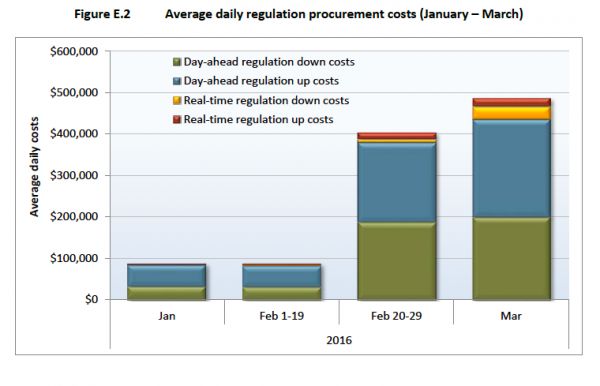California has been seen as one of the less lucrative markets for frequency regulation, the business of using power plants, batteries, chillers, pumps and other energy resources to react to second-by-second instructions to keep the grid stable.
But that’s starting to change, according to the latest data from state grid operator CAISO -- and renewable generation volatility, that is, more intermittent wind and solar in the state’s energy mix, is the root cause.
Back in February, CAISO roughly doubled its regulation requirements in the day-ahead and real-time markets where the services are bought and sold, from between 300 to 400 megawatts per day to 600 to 800 megawatts per day, according to its recently released first-quarter 2016 market report.
“As requirements increased, prices for these ancillary services increased as well,” according to the report. Over the quarter, day-ahead prices for both regulation-up and regulation-down services roughly tripled, from about $5 per megawatt-hour to about $15 per megawatt-hour.
And more resource, combined with higher prices, equaled bigger payouts from CAISO for its day-ahead markets, which tripled from an average of less than $100,000 per day in February to more than $400,000 per day in March. Real-time payments, also known as mileage payments, increased in similar volumes, but because the price paid for that market participation remains close to $0, it didn't lead to a big jump, CAISO noted.

While California’s new highs still don’t match those of the country's largest frequency regulation markets run by mid-Atlantic grid operator PJM, they’re a significant upward step. Why the sudden increase? While CAISO’s report didn’t get into details, it did cite the rise in solar and wind power, as well as the need to prepare for balancing its intermittency.
CAISO said it procured an average of 620 megawatts of regulation in its day-ahead market between the mid-February change and the end of March. On a few days, it actually hit the need for 800 megawatts, “when high amounts of renewable generation were forecast and ISO operators required additional regulation availability to accommodate potential renewable generation volatility.”
CAISO’s Department of Market Monitoring analyzed the behavior of market participants before and after the big requirement increase, and “did not identify any significant changes in the supply bids offered to the market.” That means high prices are being driven by the increased demand, rather than by suppliers holding back in the market. The report also noted that its other ancillary services products haven't changed, and haven't seen significant price volatility over the same time period.
At the same time, CAISO reported that solar generation set a new peak during the quarter at just more than 7,500 megawatts, and routinely provided 5,000 megawatts during midday hours. That increase in green energy, helped along by low natural-gas prices, pushed down energy prices, but also led to more price spikes, the report noted.
This trend has significance for California’s energy storage market, as well. To date, the state hasn’t been a target for developers of batteries, thermal energy storage systems, flywheels or other resources targeting the frequency regulation market. That’s in contrast to PJM, which leads the country in grid-scale battery deployments -- almost all of them serving the grid operator’s frequency response markets. PJM offers larger markets and comparatively higher prices, although it’s also seen complications in integrating new storage resources into its operations, as we covered in "Dispatches From the Grid Edge."
California’s energy storage growth has mainly been driven by the state’s 1.3-gigawatts-by-2020 mandate, which has laid the foundation for hundreds of megawatts of battery projects being contracted by the state’s biggest utilities. But these projects are mainly aimed at providing more predictable and longer-duration energy injection to meet their capacity and resource adequacy needs.
That’s not to say that batteries can’t be called on to do both short-scale and long-scale storage tasks. But they’re generally limited to one or the other, for practical and regulatory reasons. They’re also driven by market prices, which as we’ve seen can change in response to grid conditions.
CAISO's report didn't get into the specifics of the linkage between wind and solar and more frequency regulation, although it's holding a Market Performance and Planning Forum meeting on July 21 where the subject could be addressed.
But the need to manage the ups and downs of intermittent energy at increasing scale has become a part of the challenge going forward for many of the country's independent system operators (ISOs) and regional transmission organization (RTOs), Ravi Manghani, GTM Research energy storage analyst, noted.
CAISO is "the first operator in the U.S. to explicitly increase regulation procurement," he said. "However, other ISOs/RTOs won't be immune from the need to raise their regulation procurement. PJM and ERCOT both have explicitly modeled higher ancillary services procurement in the future owing to projected growth in wind and solar."



